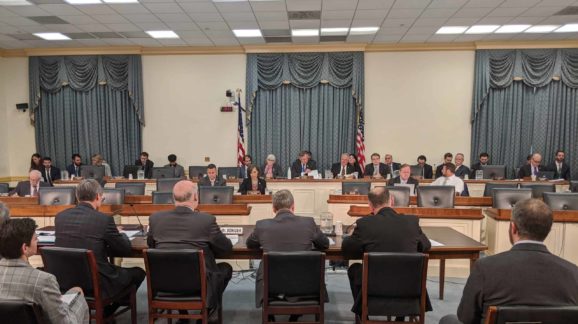Testimony of Ben Lieberman Before House Subcommittee on Environment and Climate Change
Promoting American Innovation And Jobs: Legislation To Phase Down Hydrofluorocarbons

Chairman Tonko, Ranking Member Shimkus, and Members of this subcommittee, thank you for this invitation to speak today at this hearing on H.R. 5544, the “American Innovation and Manufacturing Leadership Act of 2020.” My name is Ben Lieberman, and I am a senior fellow of the Center for Energy and Environment at the Competitive Enterprise Institute, a non-profit, non-partisan, public policy institute committed to advancing the principles of free markets and limited government. Before that, I had the distinct privilege as being a staff member for the House Committee on Energy & Commerce, including work on this subcommittee, from 2011 to 2018.
I know that a number of you have expressed misgivings about the Green New Deal or carbon taxes or other comprehensive climate change measures, and I certainly share those misgivings. But I also know that several of you are casting about for something that you can support on climate, something less controversial and costly, the proverbial low-hanging fruit or win-win proposal.
And it appears that some of you may be gravitating towards H.R. 5544, the “American Innovation and Manufacturing Leadership Act of 2020” as possibly being that vehicle. But I would strongly caution against doing so. I believe that this bill, especially in its present form, risks imposing significant and unnecessary costs on homeowners, vehicle owners, and many small business owners, and promises more economic pain than environmental gain.
The bill places limits on production of hydrofluorocarbons (HFCs). These are the refrigerants currently in use in literally hundreds of millions of air conditioning and refrigeration systems – nearly every vehicle air conditioner, many residential air conditioners and refrigerators, and the equipment used in millions of small business such as restaurants. Future repairs of this equipment, and particularly repairs of leaks that require additional HFCs, would very likely rise if supplies of HFCs become restricted.
In addition, the cost of HFC substitute refrigerants and the equipment designed to use them is also likely to be higher. For example, perhaps the most common HFC targeted under this bill is HFC-134a, which is the stuff used in your car air conditioner and refrigerator, as well as quite a bit of the equipment you might see at a food store. You can go to any of a number of online refrigerant supply houses and find HFC-134a for around $5.00 to $7.00 per pound. But its substitute, something called HFO-1234yf, can be found on those same sites for closer to $50 per pound. Make no mistake – this bill will impose costs, both higher repairs of existing equipment and a higher purchase price for new equipment.
There are a few provisions in this bill that are particularly problematic, and I would like to spend a moment highlighting them. This includes the provision that lets the deadlines be accelerated. The bill sets out a schedule of 40 percent reduction in HFCs by 2024 and an 80 percent reduction by 2034 – not great but not terrible in terms of allowing for a gradual transition. But the bill allows those deadlines to be accelerated, and even if EPA chooses not to do so, the bill’s wide- open litigation opportunities practically guarantee that environment groups will sue to do so.
This provision destroys any certainty and could lead to HFC restrictions far costlier than those originally set out for all those pieces of equipment that will still need it. At a minimum, I believe that any policy change should allow the existing generation of HFC-dependent equipment to live out it useful life undisturbed, without any higher costs, to be replaced in due course by whatever comes next. And this bill falls well short of that goal.
I also see problems with the lack of state preemption. Many issues that I worked for on this committee such as CAFE and appliance efficiency standards were complicated by California and other states going in their own direction, often for the express purpose of trying to force the issue in Washington. And that is already happening with regard to HFCs. However, this bill does nothing to rein in states that want to continue setting conflicting HFC measures. One set of federal HFC restrictions will be enough of a challenge, we don’t need a multiplicity of requirements.
I would also add that the bill’s exceptions are far too narrow and do not provide relief should compliance costs prove to be high, especially for small businesses and consumers, or if other issues like the flammability concerns surrounding several of the new refrigerants are not resolved in time. This bill would be uncharted territory in several respects, so there should be a safety valve if things don’t go quite as well as its proponents are predicting.
There are a number of things that could be done to improve this bill, but I should add that I am not yet convinced that a bill is necessary. To put it bluntly, what would be so bad if the new stuff had to compete with the old stuff and we let the buyer decide? That’s the way it usually works when a new product is introduced. And I’m sure there are consumers and businesses that would purchase air conditioners and refrigerators advertised as the environmentally-friendlier option, and continued competition between the old and the new would be best for keeping prices down.
We can debate the merits of these new refrigerants, but we should also debate the necessity of Congress stepping in and playing favorites, especially when consumers and small business may be the worse for it.
I appreciate the opportunity to participate in this hearing and look forward to any questions you may have.